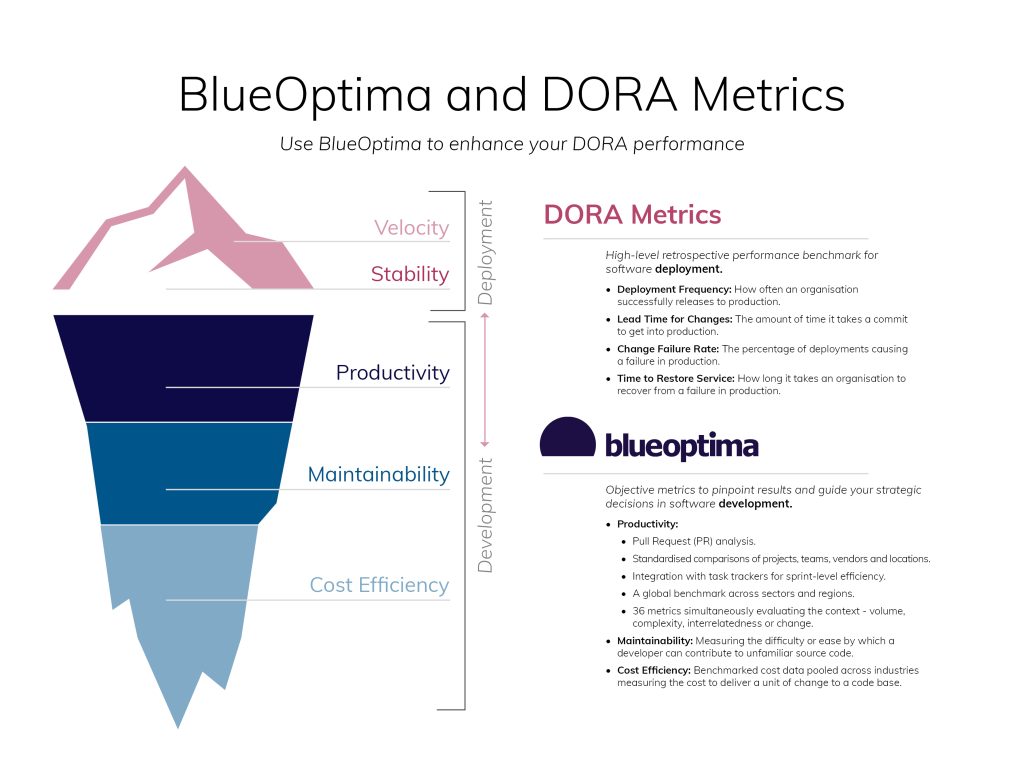
Introduction
In the realm of software development, the need for effective performance measurement is paramount. With the advent of DevOps, a set of practices that combines software development (Dev) and IT operations (Ops), the necessity to gauge and optimize performance has grown exponentially. Amidst this backdrop, DevOps Research and Assessments (DORA) metrics were born. These metrics, defined by Google Cloud’s DevOps Research and Assessments team, provide an objective, quantifiable measure to understand and optimize software delivery performance, thereby validating the business value of DevOps initiatives. However, while DORA metrics serve as an effective measure in most scenarios, their usefulness in large enterprises is a matter of debate. This article aims to explore this aspect in detail.
DORA Metrics Explained
The DORA framework is underpinned by four key metrics that measure two core areas of DevOps: speed and stability.
- Lead Time to Change: This metrics measures the duration from code commit to successful deployment in production. Its reduction, implying quicker value delivery, can be achieved through strategies like adopting CI/CD, automation, and lean principles, while ensuring quality doesn’t suffer in the pursuit of speed.
- Deployment Frequency: This metric is a barometer of how often an organization deploys code to production or releases software to end users. It essentially gauges the pace of software delivery, helping teams understand their standing in relation to their goal of continuous deployment. The benchmarks for deployment frequency range from elite (multiple deployments per day) to low (fewer than one deployment every six months).
- Change Failure Rate: This metric represents the percentage of deployments that cause a failure in production and require an immediate fix. The objective is to minimize this rate, as a lower change failure rate allows teams to focus more on delivering new features and customer value, rather than addressing failures.
- Time to Restore Service: Often referred to as mean time to recover or repair (MTTR), this metric measures the speed at which a team can restore service when a failure impacts customers. The benchmarks for this metric range from less than an hour (elite) to more than six months (low).
Applications and Benefits of DORA Metrics
DORA metrics have found widespread application across various industries, enabling companies to measure and improve their software development and delivery performance. For instance, a mobile game developer might use DORA metrics to optimize their response when a game goes offline, thereby minimizing customer dissatisfaction and preserving revenue. Similarly, a finance company could articulate the positive business impact of DevOps to stakeholders by translating DORA metrics into monetary savings through increased productivity or decreased downtime.
The adoption of DORA metrics leads to improved decision-making, as these metrics provide concrete data about the state of the development process, thereby enabling organizations to make informed decisions about how to enhance it. By focusing on specific metrics, teams can more easily identify bottlenecks in their process and concentrate efforts on resolving them.
Limitations of DORA Metrics and the Need for Alternatives
Despite the undeniable benefits of DORA metrics, their applicability in large enterprises is limited. In large teams, the Change Failure Rate and Time to Restore Service often become so low that they become statistically insignificant, making these metrics less useful. Additionally, large enterprises face unique challenges that DORA metrics may not fully address.
For instance, large teams often grapple with significant technical debt and lock-in due to past stack, infrastructure, or cloud choices. The upskilling required for migration is usually time-consuming and challenging given the team’s current responsibilities. Moreover, building in-house solutions to overcome these challenges could take months, and even then, the burden of maintenance post-creation falls on the team. The result is a loss of productivity and potential cost savings due to the inability to adopt newer approaches swiftly.
In addition, a key challenge lies in the sheer size and complexity of these organizations. Large enterprises tend to have numerous development teams, often spread across various locations and time zones, working on disparate projects. This fragmentation makes it challenging to uniformly apply and consistently track DORA metrics across the organization. Furthermore, with larger teams, there are more variables in the development process, making it difficult to maintain the comparability of measurements over time.
The evidence suggests that faster LTTC does not equate to higher productivity, highlighting the need for a multifaceted approach to performance measurement. This realization drives the recommendation for incorporating a broader set of metrics, including those focusing on code quality and productivity, to accurately gauge software development efficiency. For an in-depth exploration, accessing the full analysis is advisable for those seeking to refine their development metrics strategy. Access the analysis here.
Alternatives to DORA Metrics in Large Enterprises
As organizations scale and evolve, they may require additional or alternative tools to effectively manage their DevOps practices. One alternative is BlueOptima’s Developer Analytics.
Developer Analytics provides objective and language-agnostic productivity and maintainability metrics to realize full software innovation potential by accelerating the improvement of development productivity and quality. It delivers integrated software development process analytics to deliver better software, faster, and at a lower cost.
Conclusion
While DORA metrics have proven to be beneficial for DevOps teams, their applicability may be limited in large enterprises due to the inherent complexity of such organizations. As a result, organizations might need to adopt alternative tools or platforms that offer more tailored solutions to provide deep and actionable insights that will enable organisations to make real and measurable improvements to their software development processes.

Related articles...

Article
Inside the $55 Billion Breach Puzzle: What Data Breaches Really Cost Enterprises
When thinking about the financial impact of cybersecurity breaches, the…
Read More
Article
How Software Quality Metrics Boost Team Performance
Measuring software delivery speed has become second nature for many…
Read More
Article
The Real Price of Technical Debt
For understandable reasons, businesses often prioritise speed over software quality….
Read More
Bringing objectivity to your decisions
Giving teams visibility, managers are enabled to increase the velocity of development teams without risking code quality.
out of 10 of the worlds biggest banks
of the S&P Top 50 Companies
of the Fortune 50 Companies